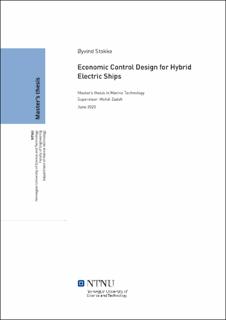| dc.contributor.advisor | Zadeh, Mehdi | |
| dc.contributor.author | Stokke, Øyvind | |
| dc.date.accessioned | 2023-05-15T17:20:20Z | |
| dc.date.available | 2023-05-15T17:20:20Z | |
| dc.date.issued | 2020 | |
| dc.identifier | no.ntnu:inspera:54166542:20679056 | |
| dc.identifier.uri | https://hdl.handle.net/11250/3068038 | |
| dc.description.abstract | Ei av dei store globale utfordringane vi står overfor er miljøendringar, med aukande temperaturar og meir ekstremvêr. Den maritime industrien er ein stor bidragsytar til verdas utslepp, med omkring3%av både dei årlege globale CO2 utsleppa og dei årlege globale drivhusgassutsleppa. For å klare å n å klimamåla som verda har vorte einige om, er behovet for innovasjonar og effektive løysingar tydeleg.
Ei framvoksande metode for å redusere utslepp og drivstofforbruk er hybride kraftsystem, der energilagringssystem (ESS) kan brukast for å redusere bruken av fossile brennstoff. I denne avhandlinga er hybride kraftsystem sett nærmare på, og ei algoritme for eit energistyringssystem for eit batteri/generatorsett (gensett) hybridskip er foreslått. Eit litteraturstudie på hybride kraftsystem er gjennomført, der fleire aspekt er undersøkt: Forskjellige topologiar for kraftsystem er diskutert, nokre teknologiar for ESS er undersøkt og samanlikna, og den typiske styringsstrukturen for hybride kraftsystemet og dei tilhøyrande komponentane er sett nærmare på.
Energistyringsalgoritma som er foreslått baserer seg på Blanda Heiltal Kvadratisk Programmering (MIQP). Den minimerar dei totale operasjonskostnadane gjennom å kalkulere optimale effektsettpunkt for batteri og gensett. Settpunkta er kalkulert ut ifrå ei minimering av drivstofforbruk, batterielding, variasjonar i ladetilstand, variasjonar i lasttilstand for gensetta og den vekta summen av aktive gensett. Dei totale kostnadane er evaluert basert på drivstoffkostnad, CO2 avgift, vedlikehaldskostnad og kostnad for batterielding.
Algoritma er testa på lastprofil henta ut frå to typer fartøy i operasjon, eit forsyningsfartøy(PSV) og ei ferge. Oppførselen er samanlikna med resultat henta ut frå fartøysdata, og fire casar er testa for kvart fartøy: optimal styring utan batteri og optimal styring med batteri for tre forskjellige batteristørrelsar. Resultata viste den lågaste totale operasjonskostnaden for optimal styring utan batteri for begge lastprofilane. Reduksjonen i kostnad var større for PSV’en enn ferga, med 3.2% mot 0.8% reduksjon. Optimal kontroll med batteri for PSV’en viste det lågaste drivstofforbruket og vedlikehaldskostnaden, men relativt høg kostnad for batterielding. Dette resulterte i litt høgare totalkostnad samanlikna med fartøysdataen, med 0.5% auke for tilfellet med det minste batteriet. For fergecasane med batteri, viste resultata små reduksjonar i drivstofforbruk og betydelige reduksjonar i vedlikehaldskostnad. På grunn av veldig høge batterieldingskostnadar vart totalkostnadane likvel auka voldsomt med mellom 23.3% og 27.2%. | |
| dc.description.abstract | One of the large global challenges we are facing today is the environmental issues, with increasing temperatures and more extreme weather conditions. The maritime industry is a large contributor to the world’s emissions with around3%of both the annual global CO2emissions and the annual global greenhouse gas emissions. In order to reach the climate goals the world has agreed upon, the need for innovations and more efficient solutions are clear.
One of the emerging means to reduce emissions and fuel consumption is hybrid power systems, where the use of energy storage systems (ESS) allows for reduced use of fossil fuels. In this thesis, hybrid power systems are investigated and an energy management system (EMS) algorithm is proposed for a battery/genset hybrid ship. A literature study on hybrid power systems has been conducted, where several aspects of hybrid power systems are investigated: Different power system topologies are discussed, a few ESS technologies are investigated and compared, and the typical control structure and its components are examined.
The energy management algorithm proposed is based on Mixed-Integer Quadratic Programming (MIQP). It minimizes the total costs of operation through calculating optimal power set points for the battery and the different gensets. The set points are calculated based on a minimization of fuel consumption, battery degrading, state of charge variations, genset load transients and the weighted sum of active gensets. The total costs are evaluated based on the fuel cost, the cost for CO2 taxes, the maintenance cost and the battery degrading cost.
The algorithm is tested on load profiles extracted from vessel operation for two vessel types, a platform supply vessel (PSV) and a ferry. The performance is compared with results extracted from vessel data, and four cases are tested for the two load profiles: optimal control without battery and optimal control with battery for three different battery sizes. Results showed the lowest total cost for optimal control without battery for both load pro-files. The reduction was larger for the PSV with a 3.2% reduction compared to only 0.8% for the ferry. Optimal control with battery for the PSV showed the lowest fuel consumption and maintenance cost, but relatively high battery degrading costs. This resulted in a slightly higher total cost compared to vessel operation, with the smallest battery giving a 0.5% increase. For the ferry case, optimal control with battery showed small reductions in fuel cost and significant reductions in maintenance cost. But due to very high battery degrading cost, the total cost was increased by between 23.3% and 27.2%. | |
| dc.language | eng | |
| dc.publisher | NTNU | |
| dc.title | Economic Control Design for Hybrid Electric Ships | |
| dc.type | Master thesis | |
